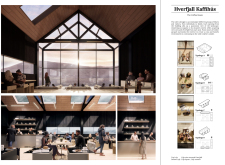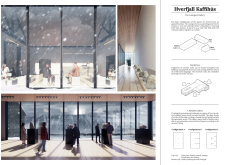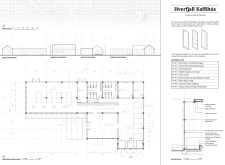5 key facts about this project
At a fundamental level, Hverfjall Kaffihús functions as both a social hub and a refuge from the elements, catering to a diverse clientele that ranges from locals to tourists. The primary aim is to provide nourishment and respite, allowing visitors to immerse themselves in the surrounding beauty while enjoying high-quality food and drinks. This dual functionality underscores the importance of public spaces in fostering community engagement and appreciation of nature’s wonders.
The design of Hverfjall Kaffihús is visually anchored by its use of natural materials that not only resonate with the region's geological features but also enhance the building’s thermal performance. The structure predominantly utilizes charred timber cladding, which not only offers aesthetic appeal but also serves practical purposes such as fire resistance and durability. A thoughtful selection of Sitka spruce and Downy birch for interior finishes creates a warm and inviting atmosphere, fostering comfort within the otherwise rugged terrain. Additionally, the extensive use of large glass panels aids in blurring the boundary between the indoors and outdoors, allowing natural light to permeate the interiors while framing panoramic views of the striking landscape.
The architectural layout is purposefully divided into several interconnected spaces, each designed to accommodate varying needs. The main coffee room is equipped with generous seating arrangements that encourage social interaction. Here, large windows provide unobstructed views of the surrounding crater, reminding guests of the volcanic backdrop and enriching their dining experience. Adjacent to this is a lounge and gallery area, which not only serves as a comfortable resting spot but also hosts local art exhibitions, thereby further deepening the connection between the café and the regional culture.
Unique design approaches are prevalent throughout Hverfjall Kaffihús, emphasizing sustainability and contextual responsiveness. The structure’s modular design streamlines construction, differentiating it from conventional building methods often seen in similar projects. This approach not only reduces the embodied energy associated with building materials but also allows for logistics that accommodate the remote nature of the site. The project embraces a rethinking of traditional forms and spaces, translating local architectural vocabulary into a contemporary language that forwards both form and function.
Furthermore, the integration of artistic elements drawn from the volcanic landscape, such as rock sculptures and locally-inspired detailing inside the lounge, enhances the café's appeal, promoting a sense of place that enriches the overall visitor experience. This attention to detail highlights how architecture can serve not just as a physical structure but also as a narrative that connects individuals to their environment.
The architectural strategies employed in Hverfjall Kaffihús are an exploration of the dialogue between built forms and natural context. This project stands as a well-considered example of how architectural design can transcend mere utility by fostering meaningful interactions between people and the landscape. Hverfjall Kaffihús invites visitors to engage more deeply with the site while enjoying a thoughtfully designed space. For those interested in exploring the nuances of this project further, a detailed examination of the architectural plans, architectural sections, architectural designs, and architectural ideas is highly recommended to gain a deeper understanding of the design nuances that characterize Hverfjall Kaffihús.


























